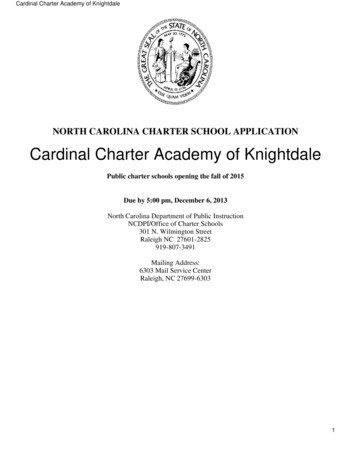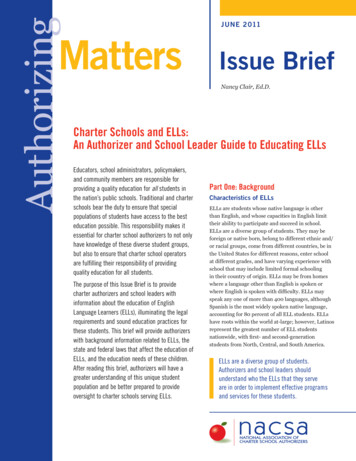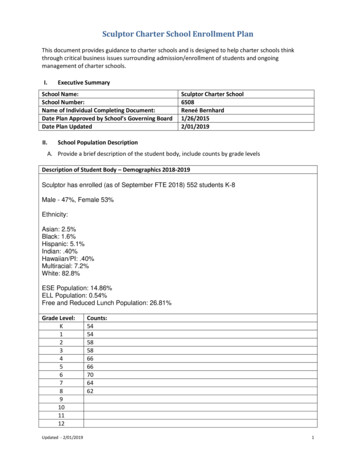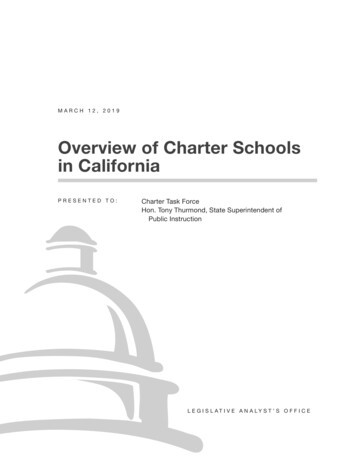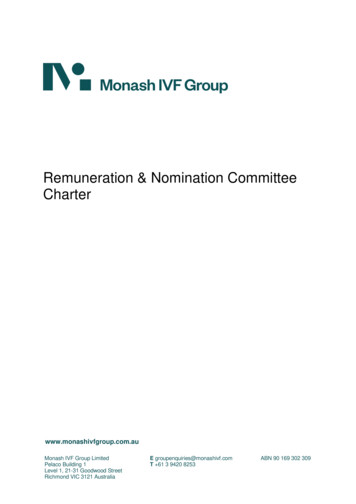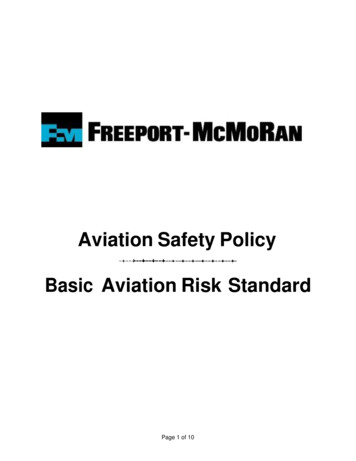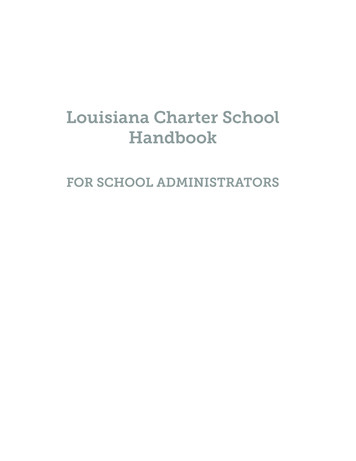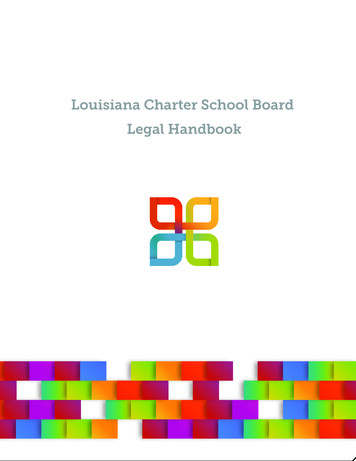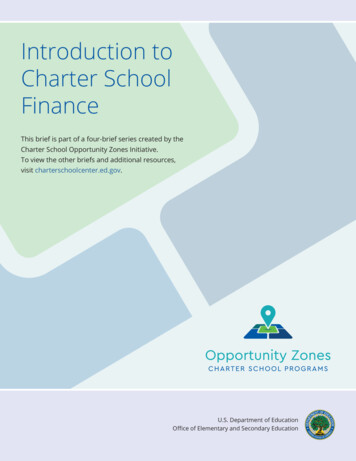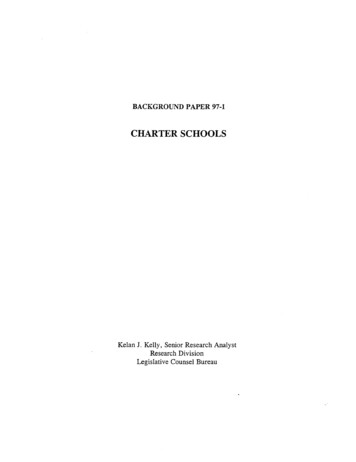
Transcription
BACKGROUND PAPER 97-1CHARTER SCHOOLSKelan J. Kelly, Senior Research AnalystResearch DivisionLegislative Counsel Bureau
TABLE OF CONTENTSIntroduction1Background2DefIning Charter Schools . . . . . . . . . . . . . . . . . . . . . . . . . . . . . . . . . . . . .2Characteristics of Charter Schools . . . . . . . . . . . . . . . . . . . . . . . . . . . . . . .3Arguments For and Against Charter Schools . . . . . . . . . . . . . . . . . . . . . . . .5Charter School Financing . . . . . . . . . . . . . . . . . . . . . . . . . . . . . . . . . . . . . . .6Key Financing Issues . . . . . . . . . . . . . . . . . . . . . . . . . . . . . . . . . . . . . . . .7Charter School Legislation in Nevada . . . . . . . . . . . . . . . . . . . . . . . . . . . . . . .8Action by the 1995 Legislature . . . . . . . . . . . . . . . . . . . . . . . . . . . . . . . . .8The Interim Study on ReconfIguring School Districts . . . . . . . . . . . . . . . . . . .9Conclusion . . . . . . . . . . . . . . . . . . . . . . . . . . . . . . . . . . . . . . . . . . . . . . . . .10Selected References . . . . . . . . . . . . . . . . . . . . . . . . . . . . . . . . . . . . . . . . . . .13Appendix. . . . . . . . . . . . . . . . . . . . . . . . . . . . . . . . . . . . . . . . . . . . . . . . . .15
CHARTER SCHOOLSINTRODUCTIONCharter schools continue to be a major focus of public school reform among educators andlegislators. Discussions regarding the benefits and drawbacks to charter schools are occurring atall levels-federal, state, and local. Proponents and opponents of the charter school concept havedeveloped extensive arguments over the merits of this recent education reform strategy. Inaddition, practically every major educational organization from the National Education Associationto the National School Boards Association has weighed in on the issue.Despite the relatively short history of the charter school movement, a great deal of legislativeactivity has already taken place. As of October 1996, 25 states and the District of Columbia hadwritten formal charter school laws. In all, about 40 state legislatures have expressed interest inthe charter school idea. 1Recent research has revealed significant differences in charter school laws from state to state.Despite the many differences, these laws are generally divided into two distinct categories:expansive statutes which generally encourage the creation of charter schools and restrictivemeasures which tend to discourage charter school formation. Many state laws contain a mixtureof both expansive and restrictive components.Charter schools have been established by individuals, teachers, nonprofit groups, businesses, andparents. Charter schools operate in a variety of settings-urban, suburban, and rural. In addition,charter schools may be organized in a wide variety of ways. For example, some may concentrateon particular themes (much like magnet schools) such as performing arts or science andtechnology. Others may emphasize a back-to-basics curriculum of reading, writing, and math.As state legislators, governors, teachers, parents, and business leaders continue to debate thequestion of how best to reform our nation's schools, the concept of independent public schoolsfocused less on traditional school management practices and more on student achievement andoutcomes will continue to attract attention.'Infonnation Clearing House, Education Commission of the States.October 1996.Denver, Colorado.
BACKGROUNDSince Minnesota passed the nation's first charter school legislation in 1991, this concept hasbecome one of the most visible efforts at reforming the nation's education system. In the 20 statesthat had passed charter school laws by the end of 1995, more than 230 charter schools hadopened. 2 The following table depicts the growth of legislative involvement in the charter schoolmovement since orgiaMassachusettsNew AlaskaArkansasDelawareLouisianaNew HampshireNew JerseyRhode IslandTexasConnecticutDistrict of ColumbiaFloridaIllinoisNorth CarolinaSouth CarolinaSource: Information Clearinghouse, Education Commission of the States. Denver, Colorado.DefIning Charter SchoolsAccording to the Education Commission of the States (ECS), charter schools are independentpublic schools, formed by teachers, parents, or other community members. These schools areexempt from most state and local laws and policies in exchange for a written contract whichspecifies certain student achievement outcomes. 3 The following section (developed by ECS staff)provides an overview of charter schools. 4Charter schools create an alternative form of public schooling. The goal of charter schools is tolift restraints from public schools so they can pursue innovative teaching methods that willimprove student performance. They are designed to give significant autonomy to individualschools and, in turn, to hold schools accountable for results.'McCotter, Sage. "Charter Schools." Clearing House Issue Brief Denver, Colorado: EducationCommission ofthe States, January 1996. p. 1.3Bierlein, Louann A. "Emerging Issues in Charter School Financing." Denver, Colorado:Education Commission of the States, May 1996. p. 1.4McCotter, Sage. "Charter Schools. Issue Brief Denver, Colorado: Education Commission ofthe States, May 16, 1995. http://www.ecs.org/ecs/220e.hnn.n2
A charter is essentially a contract, negotiated between tbose people starting the school and tbeofficial body autborized to approve tbe charter. The charter spells out how tbe school will be run,what will be taught, how success will be measured, and what students will achieve. As long astbe school meets tbe terms of its charter, it is free from many of tbe rules and regulations tbatapply to other public schools. And, unlike otber schools, if a charter school fails to meet theseterms, tbe charter can be revoked and the school closed.A charter proposal is written by a team of individuals interested in establishing a new school. Theparties eligible to start a charter school vary from state to state. Nationally, charters have beengranted to parents, teachers, community groups, and otber organizations.State law also determines tbe entity or entities that can approve a charter. In some states, it is tbestate superintendent. In most states, local school boards have the power to approve or denycharter applications. Some states, such as Michigan, allow institutions of higher education toapprove charters.There is usually a provision in each state's charter school law that describes what applicants cando if a request for a charter is denied. Some states allow alternative sponsoring organizations tostep in and/or provide for an appeals process to different governing bodies.Characteristics of Charter SchoolsThe manner in which charter schools are structured and operate is dependent on tbe type oflegislation enacted. The most common method of characterizing charter school laws is by dividingthem into two categories--expansive and restrictive. These two types of legislation differ inseveral important areas including the amount of community support for a school, tbe number ofschools allowed, the lengtb of tbe charters, and tbe level of difficulty involved witb obtaining acharter. 5 Table No.1 on pages 4 and 5 describes tbe differences between expansive and restrictivecharter school laws on twelve characteristics.5McCotter, Sage. "Charter Schools." Clearinghouse Issue Brief Denver, Colorado: EducationCommission of tbe States, January 1996. p. 1.3
Table No.1ISsueRestrictiveNumber of SchoolsPermits unlimited (or veryhigh) number of schools to bechartered.Places a cap upon the numberstatewide or within a district.Variety of SponsorsPermits mUltiple typesof sponsors-local schoolboards, state boards ofeducation, and universities.Restricts to one entity, usuallythe local school district.Variety of OperatorsPermits a variety of groups orindividuals to start charterschools-teachers, parents orother citizens, nonprofitorganizations, and businesses.Restricts type of operator,usually licensed teacher oradministrator.Variety of SchoolsPermits existing schools toconvert and new schools tostart from scratch.Restricts to conversions ofexisting schools.Appeals ProcessContains appeals mechanismwhich authorizes potentialoperators to appeal deniedapplications to a differentauthorizing body.Single chartering entity-noappeals process.Evidence of SupportPermits schools to be formedRequires documented level ofwithout documenting specified support from (some or all)level of support fromteachers, parents, andcommunity members.teachers, parents, andcommunity members.Waivers from Lawsand RegulationsBlanket waivers from allstate/district laws andregulations with the usualexceptions of electrical, fire,and safety codes, and state4Provides for no waivers ornegotiated waivers on issueby-issue basis with thesponsor.
Table No.1(Continued)IssueRestrictiveExemption fromCollective BargainingProvides charter schools withcomplete control overpersonnel decisions (hiring.fIring, salary structure,et cetera).Teachers and other personnelremain subject to districtcollective bargainingagreements .Local AutonomyCharter schools are legallyautonomous entities-theymay sue and be sued, acquirenT 1ne:rtv, and so on.Charter schools remain underschool district jurisdiction inthese matters.Fnnding Process100 percent of per pupilfunding automatically followsstudents emolled in charterschools.Amount of funding isnegotiated with district or isset at a fIxed percentage rare.Fiscal AutonomySchools have control overtheir own budgets.Restrictions or procedures setforth for budget decisions.Start-Up FundingProvides for start-up fundsor seed money. Requiresan appropriation sectionsuch funds.No extra funding for charterschool start-up costs.Source: Compiled by Legislative Counsel Bureau, Research Division staff.Arguments For and Against Charter SchoolsProponents argue that charter schools provide numerous advantages over traditional public schoolsin the delivery of quality education to students. Conversely, opponents argue that charter schoolshave the potential to adversely affect educational opportunities for children who remain in theschool district and present financial and legal risks to districts. These arguments are summarizedin Table No.2.5
Table No.2IIAdvantages of Charter SchoolsAccording to advocates. charter schools:Disadvantages of Charter SchoolsAccording to opponents, charter schools:1.Allow public schools to be createdoutside the existing educationsystem;1.Cannot be exempt from somerequirements, for example healthand safety laws;2.Encourage creativity and innovationby reducing excessive bureaucracyand regulation;2.Might use public money to supportprivate-schooling or homeschooling;3.Increase the range of educationaloptions available to children andparents;3.Are generally small, isolatedinstitutions not readily accessible tomost students;4.Promote results or "outcomes"rather than "inputs" such as theamount of time students spend inclasses;4.Operate on a small scale whichmeans that any benefits they havewill affect only a few students;5.5.Incorporate market forces in publiceducation; andWill constitute a net financial lossfor the school district;6.6.Involve parents and the communitydirectly in the operation of schools.Have the potential to become eliteinstitutions, doing nothing to serveat-risk youth; and7.School boards can still be legallyresponsible for charter schoolswhich they do not completelycontrol.,Source: McCotter, Sage. "Chaner Schools Issue Bnef.' Denver, Colorado: Educallon CommIssIon ofthe Slales, May 16, 1995.CHARTER SCHOOL FINANCINGThe degree of fiscal autonomy for charter schools depends primarily on whether theschool operates under expansive or restrictive legislation. Schools established underrestrictive statutes remain under the legal and financial control of a school district and,therefore, present few finance problems. However, those schools operated under more6I
expansive legislation are often given significant legal and fiscal autonomy.6 Theautonomous status of some charter schools raises important questions about funding forthese schools as well as other public schools in the same district.Key Financing IssuesRecent research on charter school financing conducted by Louann A. Bierlein, aneducation policy advisor to the Governor of Louisiana, and Mary Fulton, a Policy Analystwith the ECS, has uncovered a number of critical issues faced by schools, districts, andstates. 7 The following are selected finance issues that may be of interest to those debatingcharter schools in Nevada: Limited access to local operating funds. Most state charter school laws restrict accessto some or all local district operating funds. Many charter schools receive only thestate portion of funding allocated to operations. In some states, statutes guaranteecharter schools only a minimum percentage of state or local revenues (for example,80 percent in Colorado); No access to capital funds. Charter schools have not been granted access to localdistrict funds for buildings and major equipment. In addition, they do not have theability to issue revenue bonds. Charter schools must use some of their operatingfunds to obtain, equip, and maintain facilities; Limited access to district-based state or federal funding. Because certain state formulafunding allocations and some grant programs are based on district characteristics,charter schools often cannot access such funding; Cash flow problems. Many charter schools, especially small start-up schools, do nothave sufficient cash flow remaining from the previous year or the last revenuepayment to pay expenses that come due between payments from state and localsources; Special education funding. The high costs of educating special education studentspotentially places added burdens on charter schools. Such schools must follow allstate and federal special education laws including those requiring the provision ofadequate services for special needs students, despite more limited resources.6Bierlein, Louann A., and Mary F. Fulton. "Charter School Financing." Policy BriefDenver, Colorado: Education Commission of the States, May 1996. p. L'Bierlein, Louann A., and Mary F. Fulton. "Charter School Financing." Policy Brief.Denver, Colorado: Education Commission of the States, May 1996. pp. 1-4.7
Considerations should be given to how charter schools can cover the extraordinarilyhigh costs associated with these students; Paperwork and procedures. State education departments frequently require elaborateprocedures and substantial amounts of paperwork for maintaining student counts andaccounting functions. Charter schools often need to hire additional staff for theseduties; District fixed costs. Charter schools often atrract students from several schools in adistrict or districts. School districts have certain fixed costs regardless of the numberof students in attendance. However, it may be difficult for districts to reduce somecosts even though they no longer serve some students. Since most of the per-pupilfunding allocation follows the student to the charter school, districts, while servingless students, also have less funds available to cover these fixed costs; Additional costs. While charter schools receive less per pupil funding than otherschools, they also atrract some private and home-schooled students, adding to the totalnumber of students the state and district must educate; and Equitable funding. Charter schools in many states are expected to demonstrate ahigher level of student achievement with less funding than other public schools. Thistype of school funding structure may create an uneven playing field for charterschools.CHARTER SCHOOL LEGISLATION IN l'.'EVADAThe concept of charter schools has recently caught the attention of Nevada lawmakers.Legislation allowing the formation of charter schools was introduced during the1995 Session. In addition, a legislative committee studying the structure of schooldistricts in Nevada considered the option of charter schools during the 1995-1996 interim.Action by the 1995 LegislatureThe 1995 Nevada Legislature considered establishing charter schools for the fust time.Senate Bill 31, like legislation in many states, contained elements of both expansive andrestrictive legislation. For example, the bill was restrictive in that it: 8 Limited the number of charter schools to one per county in counties with a populationof more than 35,000;'Senate Bill 31, Second Reprint.8
Allowed only one entity-school district boards of trustees-to sponsor charterschools; and Set the amount of funding at a fixed percentage of the per pupil amount rather thanallow 100 percent of per srudent funding to follow pupils to the charter school.Senate Bill 31 contained more expansive language on many characteristics by allowing thefollowing:' Any person or public body to operate a charter school; The creation of new schools or the conversion of existing ones; An appeals process for applicants whose first application was denied; The formation of schools without a documented level of parental or communitysupport; Waivers from most state and local regulations; An exemption from collective bargaining; A large degree of fiscal autonomy granted to the school's board of directors; and Start-up funding for new charter schools.The bill passed the Senate but died in the Assembly Committee on Education.The Interim Study on Reconfiguring School DistrictsDuring the 1995-1996 interim, the Legislative Commission's Subcommittee to Srudy theReconfiguration of School Districts in Nevada (Senate Concurrent Resolution No. 30,File No. 161, Statutes of Nevada 1995) received a report from the consultant hired by theLegislature to study the issue of school district boundaries. This report containedinformation and analysis on the option of charter schools as a method to improve schoolbased organization and accountability. 10 In their report, the consultants providedlegislators with information on a number of aspects of charter schools including: a'Senate Bill 31, Second Reprint.IOGuthrie, James W., et aI. Nevada School District Organization and Control: Meetingthe Challenges of Growth and Diversity. Berkeley, California: Management Analysis andPlanning Associates, August 1996. pp. 56-64.9
concise definition; the advantages and disadvantages of such schools; and a descriptionof expansive and restrictive types of legislation, including specific state examples.Based on the information provided by the consultant and testimony from numerous groupsand individuals both in support of and in opposition to the concept, this subcommitteeforwarded recommendations for establishing charter schools to the 1997 Legislature.CONCLUSIONUnlike many proposed educational reforms, charter schools enjoy support frompolicymakers across the political spectrum. These independent public schools are alsogaining support from educators and teachers unions. According to the ECS, this broadappeal makes charter schools one of the fastest growing education policy innovations. 11Despite the popularity of charter schools, important issues should be considered. Perhapsthe two most important issues for policymakers are: First, whether private schools should be allowed to convert to charter status therebyreceiving public money; and Second, whether charter schools can meet community expectations while being heldto state-set student performance levels. 12In addition, while charter schools often afford educators the opportunity for freedom andinnovation in teaching and school management, they can present governance and oversightproblems for local school districts and other sponsors.Legislators considering charter school laws are faced with balancing all of theseconsiderations with needs specific to their states. Initial evaluations appear to favorexpansive laws as a way to encourage the creation of such schools.13 Other early reports"Newman, Frank and Alex Medler. "Can Charter Schools Pressure All Schools toImprove?" Commission Connection. Volume 2, Number 11. Denver, Colorado: EducationCommission of the States, November 1996.12Newman, Frank and Alex Medler. "Can Charter Schools Pressure All Schools toImprove?" Commission Connection. Volume 2, Number 11. Denver, Colorado: EducationCommission of the States, November 1996.13McCotter, Sage. "Charter Schools." Clearinghouse Issue Brief Denver, Colorado:Education Commission of the States, January 1996. p. 3.10
indicate improved achievement for many charter school students .14 As more states adoptcharter school statutes, additional information concerning the educational effectivenessof various models will be forthcoming.l4Bierlein, Louann A. Chaner Schools: Initial Findings. Denver, Colorado: EducationCommission of the States, March 1996. p. 5.11
SELECTED REFERENCESBierlein, Louann A. and Mary F. Fulton. Emerging Issues in Chaner School Financing.Education Conunission of the States, 1996.Bierlein, Louann A. Chaner Schools: Initial Findings. Education Conunission of theStates, 1996.Bierlein, Louann A. and Lori A. Mulholland. Understanding Chaner Schools. Phi DeltaKappa Educational Foundation, 1995.Guthrie, James W., et al. Nevada School District Organization and Control: Meetingthe Challenges of Growth and Diversity. Management Analysis and PlanningAssociates, 1996.McCotter, Sage.States, 1996."Charter Schools."Issue Brief.Education Commission of theMcCotter, Sage. "Charter Schools." Clearinghouse Issue Brief. Education Conunissionof the States, 1996.Medler, Alex. "Promise and Progress: A School Leaders Update on How CharterSchools are Faring After Their First Five Years." The American School BoardJournal. National School Boards Association, 1996.Mulholland, Lori A. "Charter Schools: The Reform and the Research." Policy Brief.Morrison Institute for Public Policy, 1996.Newman, Frank, and Alex Medler. "Can Charter Schools Pressure All Schools toImprove?" Commission Connection. Volume 2, Number 11. Education Commissionof the States, 1996.United States General Accounting Office. Chaner Schools: New Model for PublicSchools Provides Opponunities and Challenges. US GAO, 1995.13
APPENDIX"Charter School Laws as of August 1996"15
Expansive LawsAZ DE94 95Nonloeal ctive 94WY95XNM93RI95GA93KSAI AK949595Xsponsor availableOR appeals processXXXXXXexists.Any person orgroup eilll XXXXXXXXXXXXBXJ)XXXXXXXBXDXXXXXXXXa charier proposal.Exemptions frommost laws, fules,XXCand policies .--lXSchool has cOlllrolover funds fromXstudent counts.Legal autonomy.No or high limitson the number ofXXXXXcharter schools thatXXXXcan he formed.Some percent ofnoncertifiedXEXXXXXteachers withouta waiver.Total 'Slronger"777777666 166655554I1332I111Componellts.Source: ThiS Informauon IS reprinted wuh pennission from Clear;nj house Notes published by the Educauon Commission of the States fEes). 707 17th SUcet. SUIte 2700. Denver.Colorado 80202-3427, (303) 299-3600. ·Copyright August 1996 ECS. All rights reserved.
Notes:A. Organizers are limited to public or private higher education institutions, a nonprofit organization, or a governmental entity.B. Teachers or parents within a district by themselves or in conjunction with any in-state higher education institution or private entity may establish a charterschool; such schools are eligible for at least 90 percent of the local levy budget per pupil, and district collective bargaining provisions automatically applyto converled public schools, while salaries for new charter schools must fall within the range established by the district in which the school is located.C. Automatically exempt from most state laws and rules, but not from local policies.D. Legally, Colorado's charier schools are to remain pari of the local school district and to receive at least 80 percent of their funds, however, many arcoperating quite autonomously.E.In Michigan, the issue or noncertified (cachers is still unclear, and certification is required except in university··sponsored schools where higher educationfaculty can teach. 00
exempt from most state and local laws and policies in exchange for a written contract which specifies certain student achievement outcomes.3 The following section (developed by ECS staff) provides an overview of charter schools. 4 Charter schools create an alternative form of public schooling. The goal of charter schools is to
